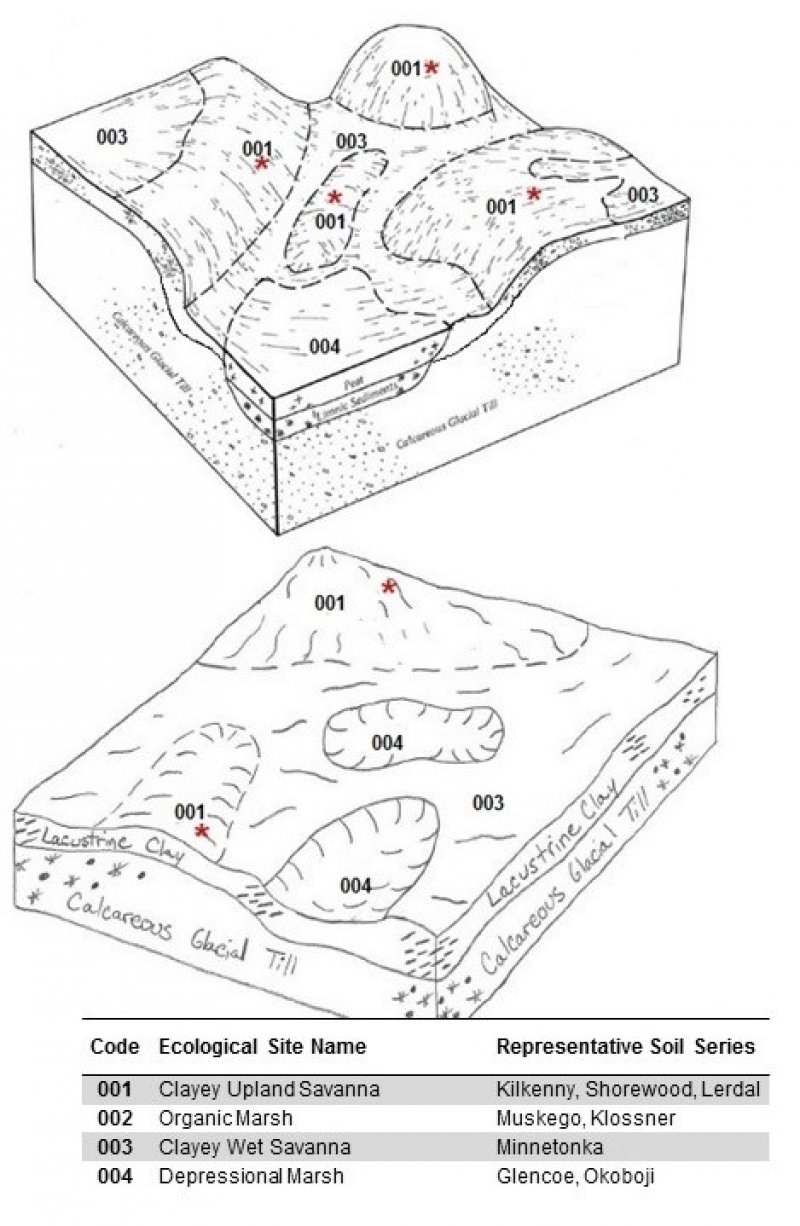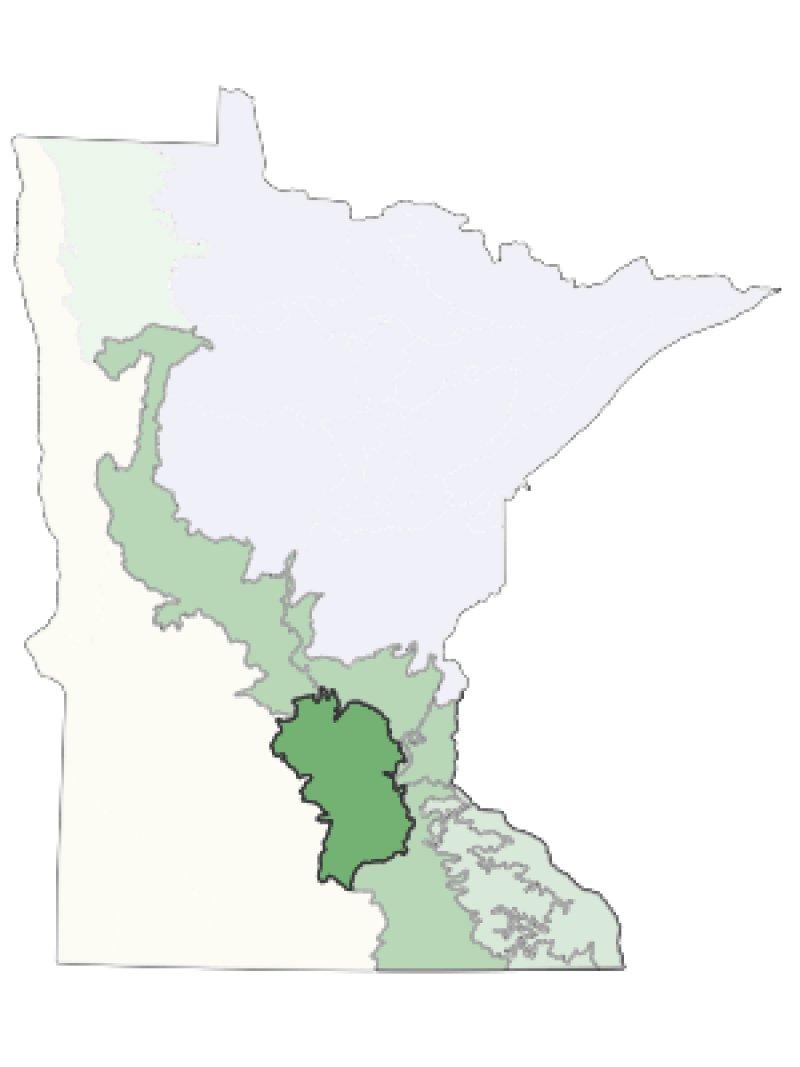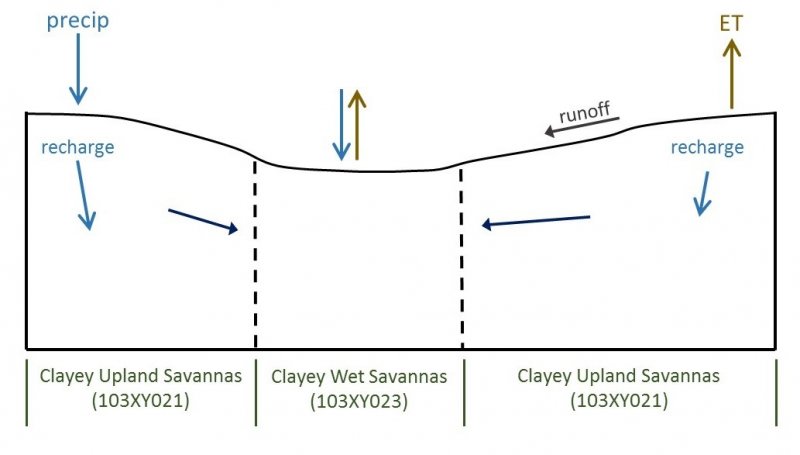Ecological dynamics
The Clayey Upland Savanna ecological site plant community is a mesic to wet mesic savanna with includes scattered oaks and native, warm-season grassses. This site is primarily located in areas adjacent to the Big Woods region of Minnesota adjacent to lakes, rivers, and streams. Natural fire disturbance was suppressed but not eliminated in these areas resulting in a savanna landscape.
The state and transition model (STM) consists of three states: Reference State, Tillage State, and the Degraded Oak Woodland State. The Reference State describes a mesic savanna with native grasses and scattered oaks. State 2 is the Tillage State which describes land transitioned to row crops. This is the most common state in MLRA 103 for this site. A few tilled areas have been reseeded to native warm season or cool-season grasses, so this community is included in the model. State 3 is a Degraded Oak Woodland State in which disturbances have modified the plant community composition and structure. Lack of natural fire, unmanaged grazing, and invasive species are common triggers transitioning a site to State 3.
State 1
Reference State
The reference state is a mesic to wet-mesic savanna community on clayey soils that exhibits a diversity of native grasses and forbs along with scattered oak species. Plant community structure and composition within are variable and dependent upon the impacts of drought, grazing, and fire events. Fire was historically present on these sites but to a lesser degree than the prairie ecological sites. This reduced occurrence of fire resulted in a plant community that included woody shrubs and scattered trees. A secondary trigger for maintenance or conversion of this ecological site is grazing. Intensive grazing can reduce the extent of highly palatable species thereby allowing the growth of less desirable plants to increase.
Fire frequency, periods of drought, and grazing will create variability in the plant community. A high fire frequency will create a shrubby prairie with a reduction in woody species. A longer fire free interval will allow trees to increase and the community will exhibit a bur oak-northern red oak savanna structure. An absence of natural fire will transition the site closer to a mixed oak woodland. Characteristic vegetation in the reference savanna state includes bur oak, northern pin oak, American hazelnut, leadplant, and big bluestem. Other prairie grasses and native forbs will also be present within the reference plant community. High-quality, untilled areas of the Clayey Upland Savannas ecological site are uncommon in MLRA 103 as most sites have been transitioned to agricultural production.
Community 1.1
Reference Community
The reference community is characterized by a savanna plant community with a diversity of native grasses, forbs, and scattered oak trees. Common reference species include bur oak, northern pin oak, American hazelnut, leadplant, big bluestem, and an array of forbs. The vegetative composition is influenced primarily by drought, grazing and fire. A mosaic of plant structure and composition will occur on these sites depending on the disturbance regime.
State 2
Tillage State
Soil tillage is the primary mechanism to transition a site to the Tillage State. In this state, dynamic soil properties such as bulk density, structure, organic carbon content, and saturated hydraulic conductivity are altered by agricultural practices. Certain practices can mitigate the impacts of traditional agricultural practices on soil health. Conservation tillage minimizes soil disturbance and can improve soil structure and overall soil health. Corn or soybean plantings and a cover crop rotation can build soil structure, improve infiltration rates, reduce runoff and erosion, and protect water quality.
Some areas in this ecological site are not appropriate for intensive crop production due to slope. Where the gradient exceeds 20 percent row crop production is not feasible due to limitations on farm machinery.
A few areas have been seeded back to warm-season or cool-season grasses. Under conservation programs such as the NRCS Conservation Reserve Program (CRP), previously tilled areas have been converted to warm-season grasslands. Native forbs are commonly included in seed mixes to benefit wildlife and pollinators. Although highly beneficial to wildlife, these sites generally lack the diversity of native plant species that occurs in the Reference State. Cool-season grasses are also feasible. Species selection will depend on the landowner’s objectives and site specifics.
Most areas in this state will remain in use for crop production in the foreseeable future – primarily in an intensive corn and soybean rotation.
Community 2.1
Tillage Community
The Tillage Community typically consists of intensively produced, traditional row crops. Tillage and intentional plant establishment (crop seeding) are the primary triggers for this community. The most common crops are corn and soybeans on an annual rotation. This community is feasible for lower slope areas.
Community 2.2
Seeded Grassland Community
The primary mechanism of change to this community is the seeding of desired grass species. This pathway is commonly triggered in conjunction with a conservation program such as the NRCS Conservation Reserve Program (CRP). The site is taken out of crop production and seeded with warm-season grasses to benefit wildlife, soil health, and water quality. A few areas within this ecological site may be seeded to cool-season grasses. Species selection depends on landowner goals.
Resilience management. Resilience management practices for warm-season grasslands include prescribed fire, brush management, and herbaceous weed treatment. Resilience management practices for cool-season grass sites include planned grazing, invasive plant management, and appropriate disturbance/harvest management.
Pathway 2.1A
Community 2.1 to 2.2
The mechanism of change is the seeding of grass species. Warm season or cool season grasses may be planted depending on the landowner's objectives. Warm season grasses may be established as part of a conservation program.
| Forage and Biomass Planting |
|
Pathway 2.2A
Community 2.2 to 2.1
The site is transitioned back to cropland through tillage and seeding.
State 3
Degraded Oak Woodland
The Degraded Oak Woodland is characterized by a disturbed woodland condition. Characteristics of this site include the dominance of trees (no longer a true savanna community) and the presence of invasive plant species. Bur oak and other hardwood species have increased. Invasives, such as Kentucky bluegrass and common buckthorn, are often dominant the understory. As the tree and shrub density increases, the ground layer plant diversity transitions to more shade-tolerant forest species.
Community 3.1
Degraded Oak Woodland Community
This plant community exhibits and increase in woody species and invasive plants. Native plant diversity is decreasing. Due to the increasing shade levels, ground flora are transitioning to more shade-tolerant species. The community is no longer a savanna but transitioning to a woodland.
Transition T1A
State 1 to 2
The site is transitioned to agricultural production through tillage and seeding of desired crops.
Transition T1B
State 1 to 3
Transition mechanisms include absence of a natural fire regime, invasion of non-native plant species, and a continual increase in woody species. Native plant diversity will decrease as the community transitions from a open savanna to a closed, shaded woodland.
Restoration pathway R3A
State 3 to 1
Restoration of the site to include non-native vegetation control, woody vegetation removal, introduction of prescribed fire, establishment of desired native species.
Transition T3A
State 3 to 2
Site is transitioned to agricultural production via tillage and seeding of desired crops.




